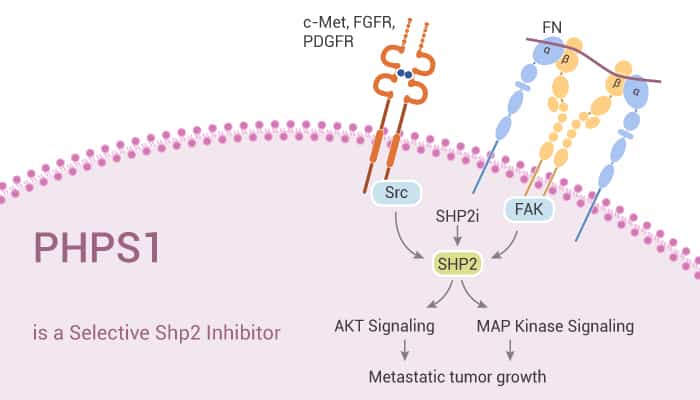SHP2 is a non-receptor protein tyrosine phosphatase (PTP) encoded by the human PTPN11 gene. Particularly, SHP2 contains a PTP catalytic domain and two SH2 domains. SHP2 is a ubiquitous PTP with a relatively conserved structure and function. Specifically, SHP2 is relevant to cell proliferation and differentiation induced by various growth factors and cytokines. As an oncogene, SHP2 mainly regulates the survival and proliferation of cancer cells by activating the Ras/ERK signaling pathway. Besides, SHP2 acts as a downstream molecule of programmed cell death 1 (PD-1) signal and inhibits T cell activation.
Moreover, SHP2 is the main phosphorylation site of platelet-derived growth factor (PDGF). Furthermore, SHP2 is a pathogenic factor of many diseases, such as Noonan syndrome, LEOPARD syndrome, and bone marrow malignancy. Meanwhile, SHP2 plays different roles in almost all cancer-related processes, including cancer invasion and metastasis. The phosphatase activity of SHP2 is obviously necessary for key cancer-related signaling pathways such as Ras and PI3K. Nonetheless, SHP2 may be a potential therapeutic target because this phosphatase involves many aspects. Today, we will introduce a selective Shp2 inhibitor, PHPS1.

PHPS1 is a Selective Shp2 Inhibitor.
First of all, PHPS1 is a selective Shp2 inhibitor with Kis of 0.73, 5.8, 10.7, 5.8, and 0.47 μM for Shp2, Shp2-R362K, Shp1, PTP1B, and PTP1B-Q, respectively. Interestingly, PHPS1 with 30 μM for 6 days inhibits the proliferation of human tumor cells. Importantly, PHPS1 results in a reduction in cell numbers of between 0% (Caki-1) to 74% (HT-29). PHPS1 inhibits HGF/SF (1 unit/mL)-induced phosphorylation and thus activation of Erk1/2 over a time period of 15 min to 6 h. In contrast, transient phosphorylation of Erk1/2 after 5 min was not affected. Obviously, PHPS1 exhibits no effect on HGF/SF-induced activation of PI3K/Akt or Stat3.
In the second place, PHPS1 reveals a significant decrease in atherosclerotic plaque size in the aorta compared with the other two groups. Additionally, PHPS1 with 3 mg/kg/day by i.p. injection during the last week on the high-fat diet renders Ldlr-/- mice less susceptible to atherosclerosis development.
All in all, PHPS1 is a potent and selective Shp2 inhibitor.
References:
Klaus Hellmuth, et al. Proc Natl Acad Sci U S A. 2008 May 20;105(20):7275-80.